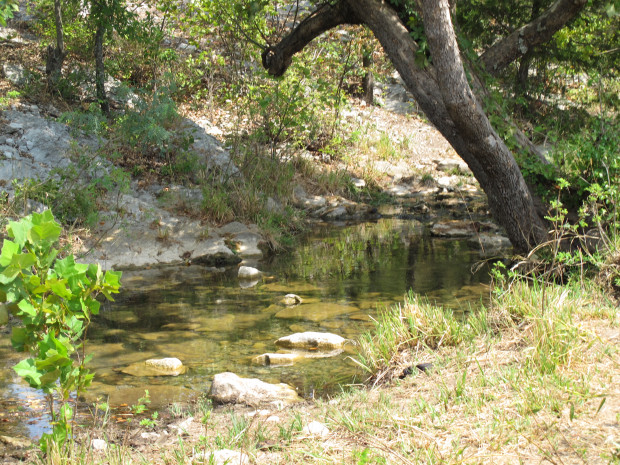
Mill Creek, southwest of Ada's Byrd's Mill Creek in south-central Oklahoma, also originates from the Arbuckle-Simpson Aquifer.
Logan Layden / StateImpact Oklahoma


Mill Creek, southwest of Ada's Byrd's Mill Creek in south-central Oklahoma, also originates from the Arbuckle-Simpson Aquifer.
Logan Layden / StateImpact Oklahoma

Logan Layden / StateImpact Oklahoma
Mill Creek, in south-central Oklahoma, originates from the Arbuckle-Simpson Aquifer.
The land above the Arbuckle-Simpson aquifer — perhaps Oklahoma’s most sensitive water resource — is dotted with great chasms, some empty, some filled with groundwater that’s seeped in.
It’s the result of pit mining by mostly out-of-state companies eager to get their hands on the area’s rich deposits of silica sand, often used for hydraulic fracturing, and some of finest limestone in the world.
But property owners along Mill Creek, which is fed by the aquifer, are reporting low water levels. The landowners blame the mining companies for pumping out massive amounts of groundwater as they bore through the aquifer.
Water use in pit mining has been largely unregulated to this point, but that’s about to change.
The Oklahoma Water Resources board has been charged by the legislature with creating new rules for the monitoring and management of aquifer water displaced by mining. The process is ongoing, but the OWRB has sent proposed rules to interested parties like Citizens for the Protection of the Arbuckle-Simpson Aquifer and mining companies.
The rules appear fairly strict. New mines will have to report how much aquifer water is being displaced down to the amount of water still dampening the rock when it’s hauled off.
That will be difficult enough for the mining companies, but they’ll also have to show their plan to conserve the pit water by pumping it into streams or building recharge ponds.
So, problem solved, right? Wrong. CPASA is getting its first look at the proposed rules and isn’t enthusiastic.
One point of contention for the group is the fact that only companies that apply for mining permits after Aug. 1, 2011 have to manage pit water. Once the rules are approved, companies who applied for permits before the deadline only have to monitor their water use. Mining companies rushed to apply for permits before that deadline. None have applied since, say officials with the State Department of Mines.
Kevin Blackwood, a CPASA member and hydrogeologist for the Arbuckle-Karst Conservancy, says it doesn’t matter how tough the rules are if all of the companies currently mining over the aquifer are exempt from them.

Logan Layden / StateImpact Oklahoma
Hydrogeologist Kevin Blackwood navigates a cave system in the Arbuckle-Simpson Aquifer.
“That’s something I do have a problem with, because all the problems that exist currently are associated with the mines that we have right now,” he says. “I do have a problem with that exemption for them.”
But J.D. Strong, executive director of the state Water Resources Board, says the pit water management exemptions are conditional and revocable. Tougher regulations will be triggered if mining companies fail to monitor water use, or use more than their allotted share of groundwater, which varies from mine to mine.
Aside from the exemptions, Blackwood says the proposed rules are forceful, if a bit confusing.
“I’ve had a little bit of trouble understanding these, and I understand some of the attorneys have had a little bit of difficulty with it as well,” he says. “But what I can understand, I’m a little bit optimistic with. I like what I see.”
The OWRB will publicize the proposed rules in early December, and won’t finalize the rules until the agency’s January 2013 board meeting. Strong says there’s still time for changes.